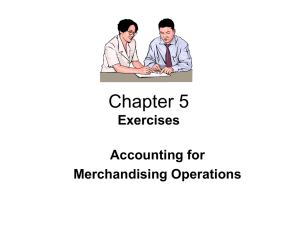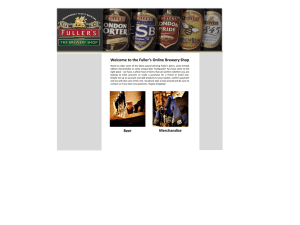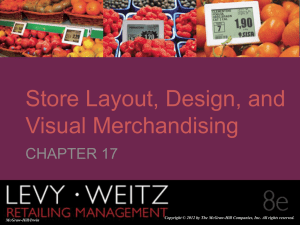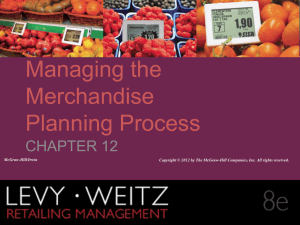Lesson 12 - Advanced Merchandising
advertisement
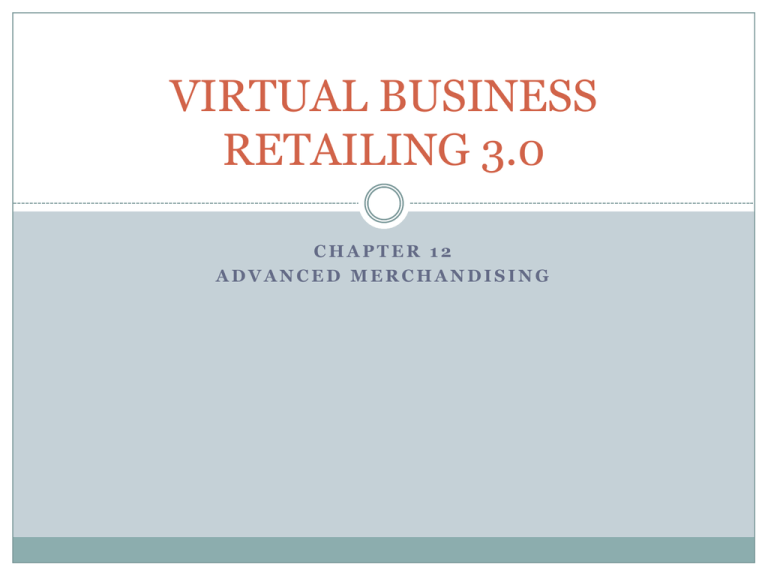
VIRTUAL BUSINESS RETAILING 3.0 CHAPTER 12 ADVANCED MERCHANDISING This unit deals with the importance of store layout, We will learn about the factors of store layout that enhance merchandise sales We will study the types of store layouts & considerations for merchandise placement Lastly, we will review math used in determining store layout After completing this lesson you will be able to: Describe the characteristics of good store layout & its impact on sales Give real-world examples of the 4 main types of store layouts – grid, loop, free flow, & spine Explain the importance of a well designed store entrance Compute sales per square foot of space & linear foot of shelving Calculate short- & long-term payments on leased vs. purchased store fixtures Evaluate the pros & cons of new equipment, & impact on sales, by analyzing financial statements Plan an effective store layout to meet sales goals Why is Store Layout Important? Store layout is the arrangement of store fixtures, equipment, & merchandise It has a major influence on sales & is important to the image & appearance of the store The arrangement of merchandise is a primary consideration when determining store layout Merchandise must be positioned so that it can be easily seen & examined by customers before they buy it Another important consideration is the visible & convenient placement of cash registers Measuring Productivity Many retailers use sales per square foot as a measure of store productivity Store layout has a significant impact on sales per square foot Grocery stores & similar businesses that display merchandise on long rows of shelves often measure their productivity in terms of sales per linear foot Regardless of the type of measurement, the goal is to make the selling area as productive as possible Creating a Store Layout A store layout should be created with 2 objectives in mind: Encourage customers to move around the store Customers who move around a store tend to view more merchandise, which leads to greater sales Retailers need to balance the flow of customer traffic around the store w/their ease of locating merchandise If customers move around the store w/o locating the merchandise they seek, they may become frustrated & leave w/o making a purchase Provide a space that is sufficient for customers to shop in & that is useful for max. productivity A selling space that is overcrowded w/fixtures & racks can become confusing & overwhelming to customers Types of Store Layouts There are 4 main types of floor layouts in use in most stores They are the grid, loop, free flow, & spine pattern layouts Each layout pattern meets specific merchandising needs Grid Characterized by long rows of shelving w/aisles between the rows Shelves are designed to hold a large amount of merchandise More merchandise can be displayed on the sales floor w/the grid layout than w/other layout patterns Easy for customers to find specific merchandise Typically used in grocery stores & drugstores Loop Designed to lead customers from the front of the store, through the store, & back to the front—or in a loop around the store Provides the best opportunity for customers to see the most merchandise Many dept. stores use this layout as a way of encouraging customers to see several departments during a visit Free Flow Features merchandise on fixtures that are arranged in asymmetrical or free flowing patterns on the sales floor This is a casual layout that encourages customers to browse as they travel through the store Is visually attractive, but can use a great deal of selling space Many small specialty stores & certain departments of department stores use this layout Spine Features a center aisle that extends from the front of the store to the back Merchandise fixtures are arranged on either side of the spine using either the free flow or grid layout Merchandise is also on both sides of the center aisle Some drugstores use this layout, using the center aisle or spine to lead customers to the pharmacy at the back of the store Fixtures – Purchase or Lease? Once the layout of the store has been determined it is time to decide the types & quantities of fixtures needed to hold & showcase merchandise Fixtures are permanent or transportable store furnishings that are used to hold & display merchandise The types of fixtures depend on the types of merchandise the store carries Many fixture companies offer purchase, lease, or lease-to-buy options to retailers Some vendors even offer used fixtures for sale A storeowner should consider the options carefully against the financials & to determine which option will best help achieve the store’s goals Purchasing store fixtures means that they become the property of the store It also means a capital investment will be made for the purchase The purchase cost of fixtures & displays can be depreciated over several years, providing a tax deduction Once fixtures & displays are purchased, they lose much of their value, just the way a brand new car does once you drive it off the lot Leasing store fixtures means signing a lease agreement that spells out the terms of the lease arrangement Lease terms vary greatly Study the terms of the lease to be certain that the lease is a good one for the business It is a good idea to ask a lawyer to review any lease before you sign it Lease payments can be deducted as operating expenses for tax purposes Often the lease tax deduction is larger than depreciation deduction from buying It is important to compare the cost of leasing with the cost of financing a fixture purchase to determine which is best for your situation The Importance of a Good Entrance The store entrance provides the 1st view customers have of a store The entrance is an opportunity to set the tone & to provide the customer w/a good 1st impression of the store A well-planned, eye-catching entrance will encourage customers to enter your store Key Math Concepts Compute sales per square foot of selling space Retailers often use sales per square foot of selling space as a measure of the productivity of their selling space To compute sales per square foot of selling space, use this formula: Total net sales / total square feet of selling space Compute sales per linear foot of shelving Another way to measure selling space productivity is in sales per linear foot This measure is typically used for merchandise that is stocked on shelves To compute sales per linear foot of shelving, use this formula: Total net sales / total linear feet of shelving Summary In this unit we have studied the importance of store layout & the 4 types of store layout We discussed leasing or purchasing store fixtures & displays We then learned about the importance of a good store entrance Lastly, we reviewed some math formulas related to store layout




